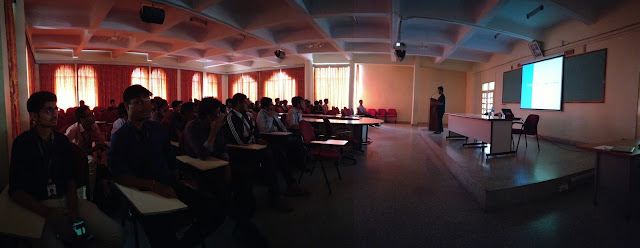
FOSSWave event in Coimbatore
What is FOSSWave?
WE ARE BUILDING A STRONG COMMUNITY
It's a place where you can learn, teach, enrich and be part of FOSS revolution!
It is an initiative to
- spread FOSS knowledge
- connect with FOSS minded people across the globe
- help students contribute to FOSS projects, tools, and technologies
- Help students become industry ready.
In addition to sharing knowledge, FOSSWave speakers also take part in organizing events and speaking in conferences across the Globe.
The FOSSWave Community consists of active contributors from across the globe. It includes both paid employees and volunteers who work towards the goals set forth in the FOSS Revolution.
Special thanks to (in no particular order)
- Premananth S: for helping us to grow, touch more lives and connecting us to KGISL
- Sudharsan Rajendran: For being a wonderful host and making sure that the event went ahead smoothly. He put in a lot of hard work.
- Prakash Mishra: or being an amazing co-speaker and traveling with me.
- Super enthusiastic participants for getting involved in our talk and discussing FOSS with us.
About the event
I had stopped writing about the events I speak in..but this was different.
A few days ago, I was invited by Prem to NASSCOM to give a brief talk on FOSS and trending technologies.
Prem is doing a great job there by putting his effort in helping students from Tier2 and Tier3 cities. Around 20 of very enthusiastic students were selected and invited to Bengaluru to take part in such events. Mine was one of them. I planned to conduct a GitHub session after Intro to FOSS and brief about Fedora project.
The event was very successful with amazing feedback.
 |
| Just a picture with GitHub stickers that we distributed |
After few days Prakash and I got an invite to address few more super enthusiastic student in Coimbatore, Tamil Nadu. This workshop was for 2 days.
We had suggested not to have more than 35-40 participants as I always prefer an interactive session rather than a talk where everyone gets bored.
20 students were selected from KGISL and rest 15 from different colleges from all over Coimbatore.
Everything from traveling to accommodations was sponsored by KGISL.
We arrived Coimbatore at around 11 pm and Sudarshan was there to receive us. We were taken to a studio apartment which was full of all the facilities.
Because of some other important tasks, I never got time to make slides[1] so I decided to do that. It took more time than expected as I was trying to avoid putting too much of complex and complicated stuff.
We got up at 5:30 as the event was from 9:30 and breakfast for us were arranged at 8:00.
The moment I stepped out of the apartment, I could feel the fresh unpolluted air. The weather was same as of Bengaluru's but a cleaner version.
 |
| Just a picture of a very huge college |
In the first session, we started with FOSS and It's philosophies and soon moved to Fedora project and 'How to contribute to Fedora QA'
We covered the following topics during the time:
We covered the following topics during the time:
- FOSS and Fedora
- What is FOSS?
- Why FOSS?
- Getting industry-ready
- Discussions around diversity and contribution spectrum
- All FOSS projects are open-sourced: so contribute anywhere
- All contributors do not have to code; can be designers or can help in documenting
- How to start with FOSS
- Introduce yourself: let the world know who you are on mailing lists
- Every project has identity methods: Fedora has the Fedora Account System (FAS)
- What if you run into an issue? Use IRC!
- Fedora and contribution pathways
- start.fedoraproject.org
- apps.fedoraproject.org
- Fedora Docs
- Packaging (and using Bodhi)
- Fedora Magazine
- Recognition Model: Fedora Badges
- Creating Accounts (FAS, mailing lists, etc.)
- admin.fedoraproject.org
- For Fedora QA: all the people redirected to the QA mailing list
- Otherwise, shoot a mail to respective mailing list
- Freenode IRC webchat
Our talk covered some basics of Git and GitHub such as…
- What is version control?
- Need for a version control system
- Methods of version control
- What is the git, who developed it, and why you should use it?
- What is GitHub and why you should use it?
- Setting up and configuring git
- Stages of file tracking
- Creating a new organization and repository on GitHub
- Basic git commands: git status, git clone, git diff, git add, git commit, git push, etc.
- Hosting a static website on GitHub
- Forking and Cloning a project
- How to send PRs
- How to solve merge conflicts
The event was until 6 pm in the evening. My plan to roam around couldn't be successful as I had no sleep last night and was very tired.
*freshen up* *Dinner* and *sleep*
But wait, I had to make Ansible slides :p
Hopefully, I had my slides ready (from other events')
The next day we started with SSH and Ansible.
We explained (with demo)
- Different terminologies
- What is SSH?
- Establish a passwordless ssh connection
- Introduction to Ansible
- Inventory files
- Introduction to Virtual Machines
- Some common modules like ping, command etc
- What are playbooks
- How to write playbooks
And then, after question answer round, we wrapped up our session.
It was a great workshop with the great audience and at a great place.
We enjoyed our stay there :)
[1]Slides' links
2. Git & GitHub
3. Ansible
Some photos from our trip: (If interested, click here)









































